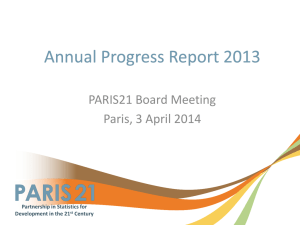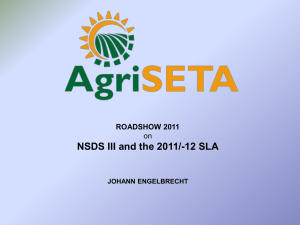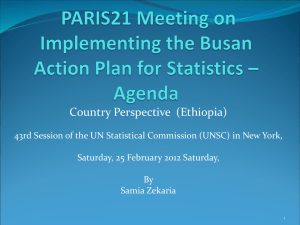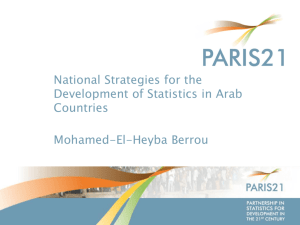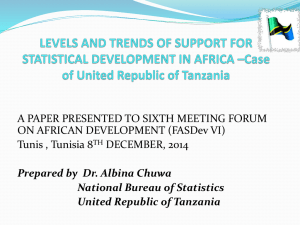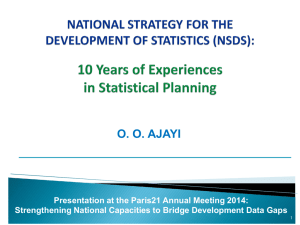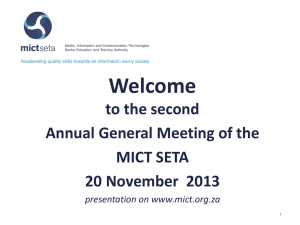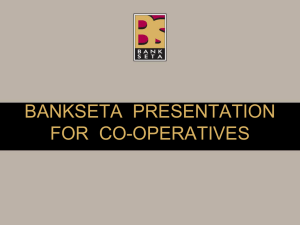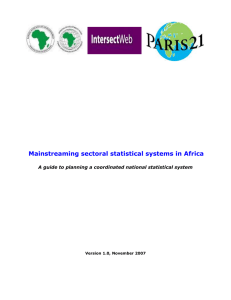Présentation PowerPoint
advertisement
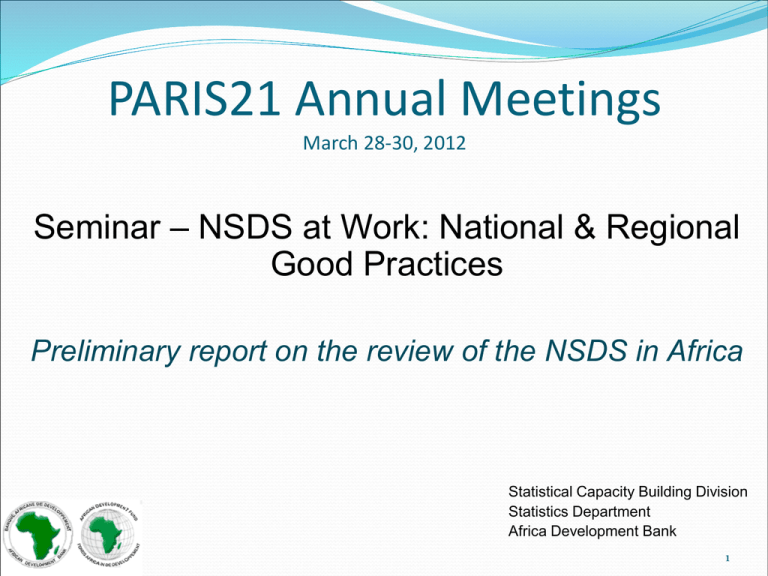
PARIS21 Annual Meetings March 28-30, 2012 Seminar – NSDS at Work: National & Regional Good Practices Preliminary report on the review of the NSDS in Africa Statistical Capacity Building Division Statistics Department Africa Development Bank 1 Contents Background Objectives of the review Scope and methodology Preliminary findings Way Forward 2 Background of the NSDS review Marrakech Action Plan (2004) recommended that all countries design NSDS by 2006 NSDS design and implementation is the overaching strategy of the Reference Regional Strategic Framework for statistical capacity building in Africa (RRSF) RRSF sets out a coherent framework to build statistical capacity initiatives in Africa in line the Marrakech Action Plan The AfDB in collaboration with UNECA coordinates the implementation of the RRSF New initiatives, new funding instruments, emerging issues/needs & new players AfDB has & continues to play a major role in supporting the design & implementation of the NSDS 3 Objective of the review Overall objective - to review the design and implementation process of the NSDS in RMCs. Specific objectives Assess NSDS essentials/principles if they are observed Identify areas of improvement with a view to provide support Identify areas that require attention of the national authorities i.e. advocacy, mainstreaming in the NDP and Budgeting 4 Scope and methodology Desk review NSDS documents, national strategy and policy (PRSP, national development plans) and all other useful documents for (29): Benin, Burkina Faso, Burundi, Cameroon, Comoros, Cote d’Ivoire, Djibouti, Gabon, Gambia, Ghana, Guinea, Kenya, Madagascar, Lesotho, Liberia, Madagascar, Mali, Mauritania, Mauritius, Niger, Rwanda, Senegal, Sierra Leone, Swaziland, Tanzania, Chad, Togo, Tunisia and Uganda. Review missions to selected countries based on a combination of issues (7): (Benin, Cameroon, Congo, Cote d’Ivoire, Djibouti, Gabon and Mali) Completed the NSDS Updating previous NSDS generation Poorly implemented, Not being implemented Target group - NSO heads, NSDS Coordinators, Sector planning officers & Development partners 5 Scope and methodology The review based on the four NSDS essentials: Integrated into the national development process, Developed in an inclusive way; incorporating results-based management principles Based on consensus-building; nationally led; UN Fundamental Principles, etc Comprehensive and coherent Political support & commitment; demand focussed; funded as a public good;main streamed in the NDP; robust legislation Covers the NSS; long-term oriented; resource for evidence-based policy making Provision for monitoring the status of the statistical system (M&E). Assessment of the current status of the NSS; vision for statistics; outline financing requirements, etc 6 Preliminary findings 1. Integration into the development process i.e. promote mobilization of resources particularly from external partners (literature review) NSDS Action Plans are too big and not linked to available human and financial resources. (literature & mission) Regional and sub-regional committments/activities not well integrated or visible (literature & mission) External funds mainly for household surveys, consequently resulting Weak of economic & other routine statistics Poor harmonized NSS as some donors choose to fund the sectors to meet thier requirements (mission) Weak political support – poor advocacy (mission) Demand and better use of statistics (literature & mission review) Weaknesses Best practices Improvement in strengthening of linkages between NSDS & PRSP – Stats Council (if in existence) play an important role in the design of the NSDS (mission review) Improvement of the leadership of the process of design & managing the NSO (mission review) Govts are begining to adopt NSDS (mission review) 7 Preliminary findings Developed in an inclusive way; incoporating results-based management principles Best Practices Good coverage of traditional sectors (education, health, agric) (from mission) From mission review – only Mali has sector strategies Workshops were organized to review the NSDS developmenmt process (mission) Advocacy – (donor round tables, African day of Statistics commemorated. (Benin; twice months/year) (mission) Preparation of work program (mission) Weaknesses Poor coverage of emarging areas: gender, governance, environment & climate change mainly because the guidelines are do not exist (mission) Lack of participation regional statistical offices (mission) Weak development of sectoral strategies in many countries (mission) Weak advocacy (lack of communication plan/strategy, almost absence of the use of radio and TV, etc) (mission) Weak dissemination of NSDS documents and the process; no info on country websites (mission) Some stakeholders find the contents of NSDS workshops too technical and do not understand rational, i.e. what are benefits, role, etc (mission) Monotony - same people are invited to workshop. Need to expand to include policy makers, legislaters (mission) 8 Preliminary findings Key elements of strategic framework (3. Comprehensive & coherent; and 4. Provision of status of the statistical system (M&E)) Best practrice All countries have a road map; work plans and budgets (mission) Stats council makes decisions and approves Plan and Budget(mission) Development of elements of strategic framweork (diagnosis, vision, strategies, objectives, action plans…) (lit and mission) Assess the data demands/needs national and sectoral policies (PRSP, MDG, etc.) (mission) Reference to GDDS (literature & mission) Weaknesses The road map prepared but does not match the political agenda (mission) Funding lag – implementation not on schedule because of lack of funding (mission) Lack of prioritization of activities, - all depends on the clout of the person driving the agenda/activity (mission) Activities are too many for the available human and financial resources (mission) Identical strategies from country-tocountry and yet the problems are different (literature & mission) Weak integration of activities including coordination within the NSO (mission) 9 Preliminary Findings Implementation of the NSDS Best Practices M&E system is in place BUT weak (literature and mission) For countries advanced in the implementation – prepare & disseminate annual progress reports (mission) Dialogue among stakeholders within the NSS to some extent (mission) Statistical coordination (mission although Weaknesses (literature and mission) Reforms, institutional & legislations, establishment of coordination bodies; a key achievement of the NSDS process (mission) Mid-term or post implementation review of NSDS - partially conducted (mission) Challenges – NSO find the process too demanding given the resource constraints, espcially if it is coordinated by one person, and worse if is at a low position (mission) Lack of clear output indicators and/or statistical capacity building (literature & mission) Lack of a funding strategy and hence sustainability of funding activities is not assured (literature and mission) not in all cases) Poor link between the M&E and outputs/results Poor advocacy for mobilizing the required funds (mission) Lack or poor of human resources strategies (literature & mission) The coordination of stakeholders though in place in some countries, is still very weak 10 Way Forward Mainstream the NSDS in the national development & budgeting process Clearly defined M&E framework Develop sectoral strategies, (SSPS) Develop a funding strategy Strengthening advocacy among stakeholders, particularly among senior staff in govt so that national resources can be mobilized Improving coordination among development partners including establishment of thematic groups Elevate statistics to the highest possible office The coordination of NSDS should be at the highest level,i.e. the coordinator must hold a senior position NSDS to be driven by national authorities – leadership & ownership Review the statistical legislation to make it robust in order support the NSDS implementation requirements and emerging needs Re-design or update NSDS design to Reflect the countries’ situation and needs Make it realistic and selective according to the available resource envelope Be flexible and focus on achievable improvements Scale up the NSDS to regional economic groupings, (RSDS) Final review report will be made available as soon as possible 11 Thank you 12

